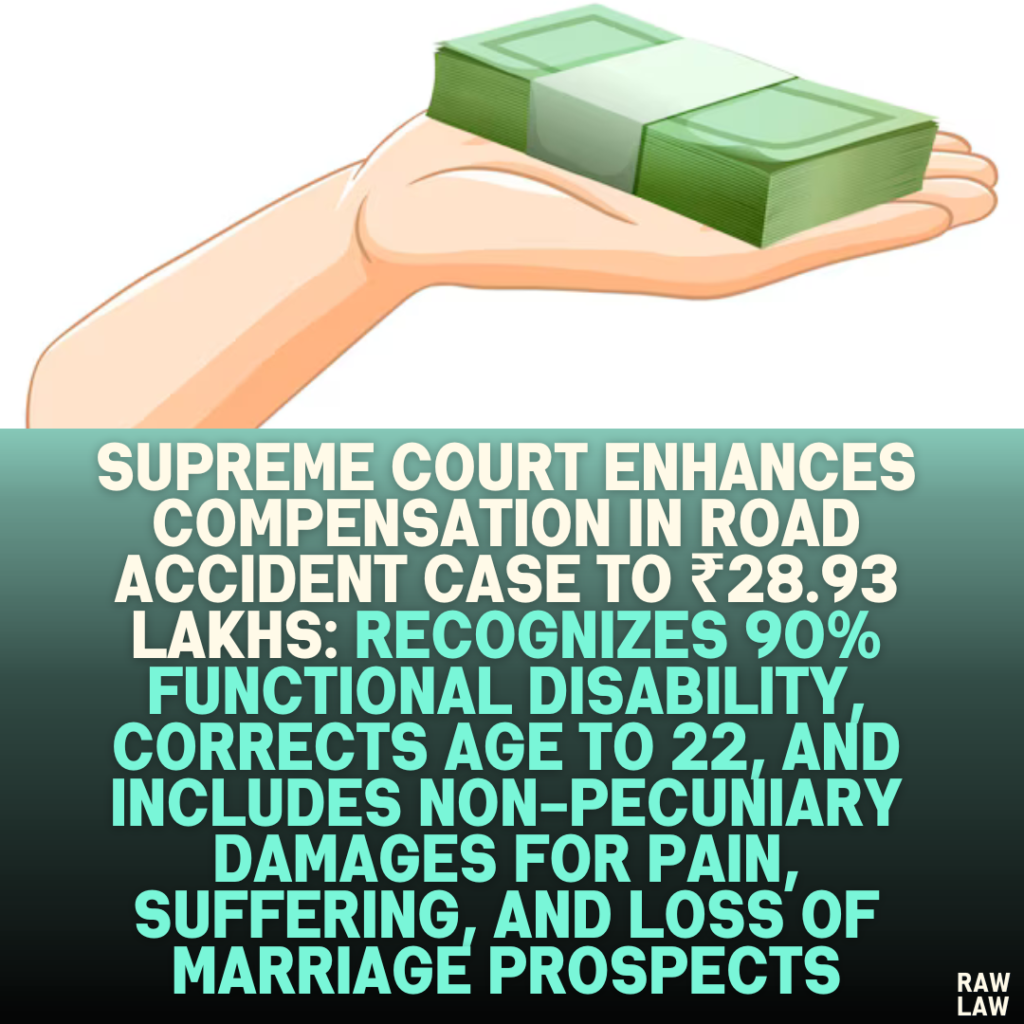Court’s Decision
The Supreme Court modified the compensation awarded to the appellant (the claimant in a road accident case) to ₹28,93,494, significantly increasing the amount from ₹6,70,000 awarded by the Motor Accident Claims Tribunal (MACT) and ₹10,10,004 awarded by the High Court. The Court recognized the appellant’s functional disability as 90%, corrected his age to 22 at the time of the accident, and recalculated the compensation by including amounts for future prospects, pain and suffering, loss of marriage prospects, and special diet.
The Court held: “Functional disability severely impacts earning capacity, especially for a self-employed person reliant on mobility.”
Facts
- The Accident:
- On April 3, 2018, the appellant, aged 23 years, was riding his motorcycle near the Gora Machhia village bus stand when he was hit by a rashly driven vehicle coming from the wrong side.
- The collision caused severe injuries, resulting in the amputation of the appellant’s right leg above the knee.
- Employment and Income:
- The appellant claimed he earned ₹25,000 per month—₹10,000 as the owner of a coaching center and ₹15,000 as an accountant for a construction company.
- He argued that the injuries rendered him incapable of continuing these professions.
- Lower Court Decisions:
- The MACT awarded ₹6,70,000, based on a notional income of ₹6,000 per month and a disability of 50%.
- The High Court enhanced the compensation to ₹10,10,004, adding ₹1,00,000 for pain and suffering and 40% for future prospects but did not adjust the disability percentage or reconsider the appellant’s claimed income.
- Appeal to the Supreme Court:
- Dissatisfied with both decisions, the appellant approached the Supreme Court, challenging the assessment of his disability, income, and age.
Issues
- Functional Disability: Was the 50% disability assessment by the lower courts justified, considering the impact of the injury on the appellant’s life and earning capacity?
- Age Assessment: Was the appellant’s age correctly determined for applying the multiplier under compensation calculations?
- Income Assessment: Did the courts err in ignoring evidence of the appellant’s income and treating him as unskilled?
Petitioner’s Arguments
- Functional Disability:
- The appellant argued that the amputation of his right leg above the knee rendered him incapable of performing basic tasks required to manage his coaching business and accounting job.
- He sought a disability assessment of 90%, emphasizing the significant impact on his mobility and earning potential.
- Age:
- The appellant contended that his age at the time of the accident was 22, not 26, and presented documents like his Aadhaar card and matriculation certificate as evidence.
- Income:
- He argued that he was a diploma holder in mechanical engineering and should be treated as a skilled worker, with an income higher than the notional figure of ₹6,000/month used by the lower courts.
Respondent’s Arguments
- No representation was made by the insurance company (Respondent No. 3), leaving the appellant’s claims uncontested.
Analysis of the Law
- Functional Disability and Earning Capacity:
- The Court considered Mohd. Sabeer v. U.P. State Road Transport Corporation (2022), which linked functional disability to loss of earning capacity, especially for individuals whose work requires mobility.
- It held that the lower courts underestimated the impact of the appellant’s amputation and raised his functional disability to 90%.
- Age and Multiplier:
- Referring to Sarla Verma v. DTC (2009), the Court applied the multiplier of 18 for individuals aged 22 at the time of the accident, as proven by documentary evidence.
- Income and Future Prospects:
- Following National Insurance Co. Ltd. v. Pranay Sethi (2017), the Court added 40% to the appellant’s income to account for future prospects.
- Compensation for Non-Pecuniary Damages:
- The Court cited precedents like Kajal v. Jagdish Chand (2020) and Sidram v. United India Insurance Ltd. (2023) to award additional amounts for pain and suffering, loss of marriage prospects, and special diet.
Precedent Analysis
- Sarla Verma v. DTC (2009): Established the multiplier method for calculating compensation based on age.
- Pranay Sethi (2017): Prescribed guidelines for calculating future prospects.
- Mohd. Sabeer (2022): Highlighted the link between functional disability and earning capacity.
- Kajal v. Jagdish Chand (2020): Basis for awarding compensation under medical expenses.
- Sidram (2023): Used to grant compensation for special diet and transportation costs.
Court’s Reasoning
- Functional Disability:
- The Court observed that the appellant’s self-employment required significant mobility, which was severely hampered by the amputation.
- Raising the disability assessment to 90%, the Court stated, “Functional disability must be assessed in light of the nature of work performed.”
- Age Assessment:
- Based on documentary evidence, the Court determined the appellant’s age at the time of the accident to be 22, not 26.
- Accordingly, the multiplier of 18 was applied.
- Income Assessment:
- The Court upheld the notional income of ₹6,000/month, citing insufficient proof of higher earnings. However, it added 40% for future prospects as per Pranay Sethi.
- Comprehensive Recalculation:
- The Court awarded compensation under various heads, including pain and suffering, loss of marriage prospects, and special diet, totaling ₹28,93,494.
Conclusion
The Supreme Court allowed the appeal, significantly enhancing the compensation to ₹28,93,494 and directing that the interest rate of 6% per annum, as awarded by the MACT, shall apply.
Implications
This judgment emphasizes:
- The importance of accurately assessing functional disability in cases involving self-employed individuals.
- The need for courts to carefully evaluate documentary evidence to determine age and apply the correct multiplier.
- Recognition of the broader impacts of injuries, including non-pecuniary damages like loss of marriage prospects and pain and suffering.




Pingback: Bombay High Court Upholds Arrest Procedure Under BNSS, 2023: "Four-Minute Delay in Communicating Grounds of Arrest Satisfies Fundamental Rights Compliance" - Raw Law